Beautiful Forms to See STEM Kaleidoscope Education will:
- Increase knowledge of science, technology, engineering, art, and math (STEAM) with a hands-on project
- Encourage investigation into inventions, past to present
- Inspire new inventions or ways of doing things
- Establish the interconnectedness of topics
- Teach about the history of kaleidoscopes and its uses
STEM stands for Science, Technology, Engineering, and Math; our nation’s emphasis toward improving education. Many educators are adding A for ART to STEM making it STEAM. One could start with any of these subjects and segue into the others. Scroll down to see flow chart for some ideas.
During the Spring of 2012, I began working with the Educator Mentor Corps of Wheelock College, Boston, MA. As part of that program, I was assigned to the art department at Timilty Middle School in Roxbury, MA. I suggested to my art teacher mentee that the 3-D, end-of-the-year assignment be a kaleidoscope. The project became the impetus for the development of the STEM Kaleidoscope Project.
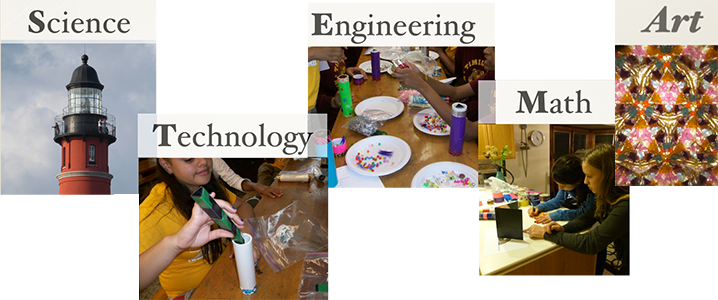
I provide consultations with teachers and/or group leaders to choose standards and objectives from the National Core Curriculum or state curriculum, such as MA Frameworks, that relate to the STEM kaleidoscope study. Then, using that information, I help teachers write lesson plans with activities, resources, and assessments. Please contact me for further information about how this program could work for your school or group.
The project is available to public & private schools, after-school programs, home schools, summer camps, library programs, civic community groups, and individuals. It is a flexible program designed to meet the needs of different ages and their educational or craft-making goals.
Even though all of the scopes are made from the same materials, each scope will be an individual one in its decorations and bead/object choices. The scopes are designed to be easily constructed, so students of all ages may be successful, PreK to adult.
Science
Science is the intellectual and practical activity encompassing the systematic study of the structure and behavior of the physical and natural world through observation and experiment. (New Oxford American Dictionary)
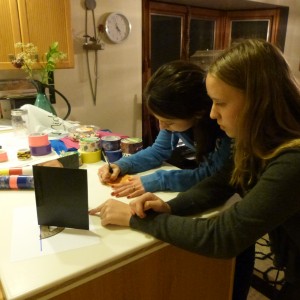
Katie and Jennifer figure out how changing the angle of the mirrors changes the number of images viewed.
Students learn about the nature of light movement, and how it can be reflected by mirrors (physics).
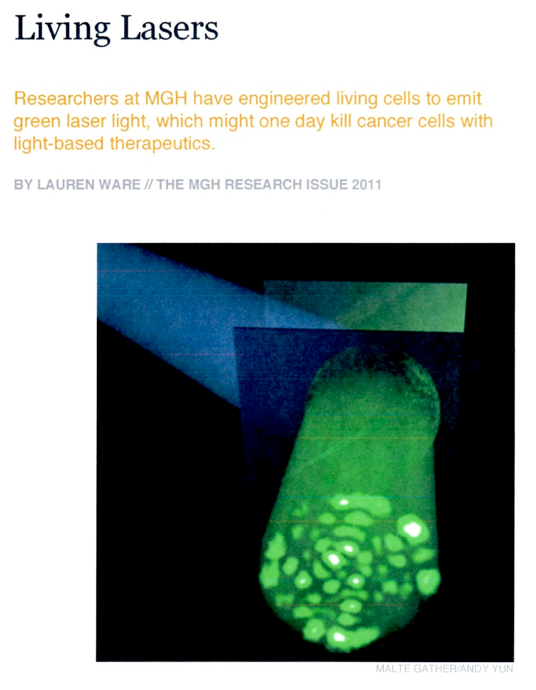
Technology
Refers to the making, modification, usage and knowledge of tools, machines, techniques, crafts, systems and methods of organization, in order to solve a problem, improve a preexisting solution to a problem, achieve a goal, or perform a specific function. (New Oxford American Dictionary)
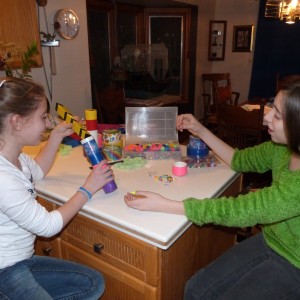
These girls are inserting mirrors and choosing beads for their Cell Scopes.
Students would construct their own kaleidoscope. They have an opportunity to use their problem-solving skills and creativity to make a unique replica of Sir David Brewster’s invention. Using some engineering and technology skills, the basic scope can be transformed into six different types of kaleidoscopes.

Engineering
The branch of science and technology concerned with the design, building and use of engines, machines and structures. (New Oxford American Dictionary)
Students will be given the opportunity to investigate how the invention of the kaleidoscope led to an important invention, the Fresnel lens. That invention led to the further study of lenses and to other scientific discoveries and inventions, including fiber optics.
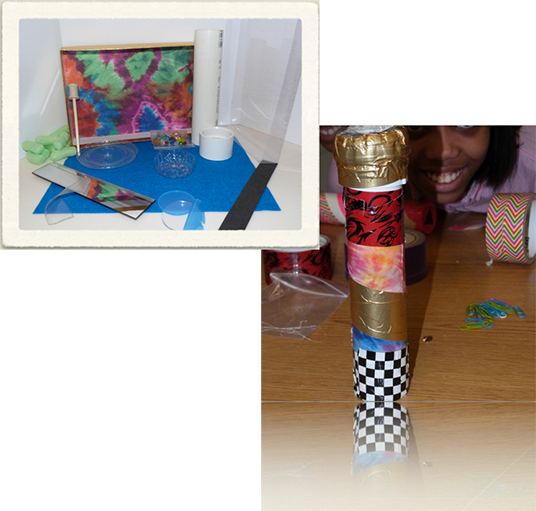
Art
Art is the expression or application of creative skill and imagination, typically in forms such as painting, sculpture or architecture, producing works to be appreciated primarily for their beauty or emotional power.”
Art has a diverse range, such as prehistoric art, contemporary art, commercial art, applied art, functional art, performance art, visual art, decorative art, and much more.
The MA Frameworks and the national Core Curriculum lists the skills in Art as:
- Generating
- Problem Solving
- Creating
- Expressing
- Realizing
- Performing
- Responding
- Appreciating
These are the same skills required in Science, Technology, Engineering and Math. So, I believe that STEM should be STEAM… to include the Arts.
Math
The abstract science of number, quantity, and space. Mathematics may be studied in its own right ( pure mathematics), or as it is applied to other disciplines such as physics and engineering ( applied mathematics). (New Oxford American Dictionary)
One of the activities is to discover how the images are affected as the mirror angles are increased or decreased. For example, an equilateral triangle of 60 degree angles results in a mandala with six, symmetrical segments.
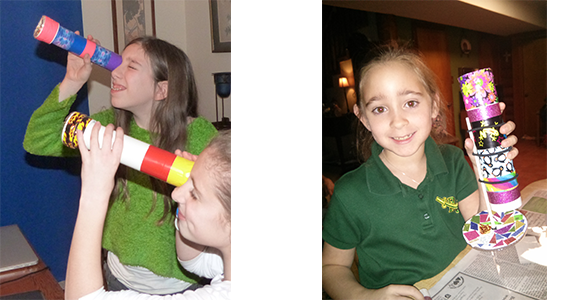
Admiring their scope creations!

Putting it All Together
Students have an opportunity to read biographies about the three main persons involved in the invention and popularity of kaleidoscopes: Sir David Brewster, Charles Bush, and Cozy Baker.
Also available are a wide variety of books, articles and websites associated with the use of mirrors in scientific equipment, and professions using mirror technology. They usually have an opportunity to apply the knowledge they’ve learned about light and mirrors with interactive websites or playing Laser Khet 2.0, the Menza Select Toy of the Year Finalist.
Greek Root Words
Sir David Brewster named his new invention using three Greek root words: kalos meaning “beautiful”, eidos meaning “form or shape”, and scope meaning “to see”. So, kaleidoscope means “beautiful form to see”. That fact provides a wonderful segue into teaching Greek root words to improve vocabulary.
Connections
The following flow chart demonstrates a variety of topics that were generated from a STEM (STEAM) Kaleidoscope Project. Each flow chart would be different; depending on the curriculum goals and objectives and/or the interests of students. The possibilities are unending.
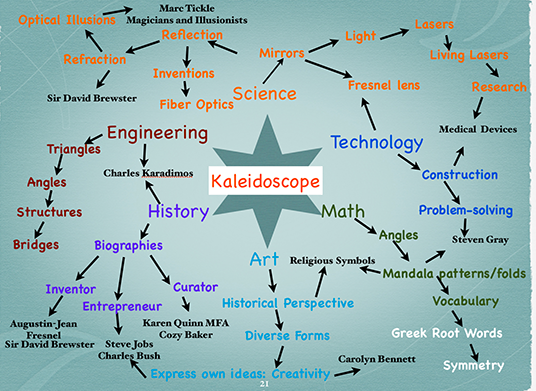
Testimonials
~Betty Davidson, Induction Manager/Teach Next Year, University of Massachusetts, Boston
~ Patty Starr, Cleveland, Ohio
~ Liz Peterson, Teacher, MA
~ Renee Simmons, 1st grade teacher, Dorchester, MA
